Preparation and Performance Study of Photoconductive Detector Based on Bi2O2Se Film
Abstract
:1. Introduction
2. Materials and Methods
2.1. Materials
2.2. Synthesis of Bismuth Oxyselenide
2.3. Characterization
2.4. Construction of Photodetectors
2.5. Photodetector Performance Test
3. Results and Discussion
4. Conclusions
Supplementary Materials
Author Contributions
Funding
Institutional Review Board Statement
Informed Consent Statement
Data Availability Statement
Conflicts of Interest
References
- Chen, G.X.; Wu, J.; Wang, B.; Li, J.; Qi, X. High-performance self-powered photodetector based on Bi2O2Se nanosheets. Appl. Phys. A Mater. Sci. Process. 2020, 126, 579. [Google Scholar] [CrossRef]
- Pi, L.J.; Li, L.; Liu, K.L.; Zhang, Q.F.; Li, H.Q.; Zhai, T.Y. Recent Progress on 2D Noble-Transition-Metal Dichalcogenides. Adv. Funct. Mater. 2019, 29, 1904932. [Google Scholar] [CrossRef]
- Sun, Y.; Zhang, J.; Ye, S.; Song, J.; Qu, J.L. Progress Report on Property, Preparation, and Application of Bi2O2Se. Adv. Funct. Mater. 2020, 30, 2004480. [Google Scholar] [CrossRef]
- Tao, H.Y.; Wang, T.L.; Li, D.Y.; Xing, J.; Li, G.W. Preparation, properties, and applications of Bi2O2Se thin films: A review. J. Semicond. 2023, 44, 031001. [Google Scholar] [CrossRef]
- Chen, P.; Shan, X.; Lin, X.; Yuan, H.Y.; Xie, Y.Y.; Wang, F.; Zhang, K.L. Controlled synthesis of high crystallization Bi2O2Se film and its photoelectric properties. Mater. Sci. Eng. B Adv. Funct. Solid-State Mater. 2022, 286, 116061. [Google Scholar] [CrossRef]
- Chitara, B.; Kolli, B.S.C.; Yan, F. Near-Infrared photodetectors based on 2D Bi2S3. Chem. Phys. Lett. 2022, 804, 139876. [Google Scholar] [CrossRef]
- Gao, W.; Zheng, Z.Q.; Wen, P.T.; Huo, N.J.; Li, J.B. Novel two-dimensional monoelemental and ternary materials: Growth, physics and application. Nanophotonics 2020, 9, 2147–2168. [Google Scholar] [CrossRef]
- Yu, M.; Fang, C.C.; Han, J.F.; Liu, W.L.; Gao, S.M.; Huang, K. Construction of Bi2O2Se/Bi2Se3 Van Der Waals Heterostructures for Self-Powered and Broadband Photodetectors. ACS Appl. Mater. Interfaces 2022, 14, 13507–13515. [Google Scholar] [CrossRef]
- Yang, M.; Zhang, X.Q.; Zhou, H.X.; Fu, G.; Zhou, X.; Lian, Y.L.; Hao, J.X.; Yu, H.; Zhu, X.Y.; Wang, J. In situ preparation of Bi2O2Se/MoO3 thin-film heterojunction array flexible photodetectors. J. Mater. Chem. C 2022, 10, 15377–15385. [Google Scholar] [CrossRef]
- Parida, A.; Senapati, S.; Naik, R. Recent developments on Bi-based oxychalcogenide materials with thermoelectric and optoelectronic applications: An overview. Mater. Today Chem. 2022, 26, 101149. [Google Scholar] [CrossRef]
- Xue, X.; Ling, C.C.; Ji, H.G.; Wang, J.Y.; Wang, C.K.; Lu, H.P.; Liu, W.P. Self-Powered and Broadband Bismuth Oxyselenide/p-Silicon Heterojunction Photodetectors with Low Dark Current and Fast Response. ACS Appl. Mater. Interfaces 2023, 15, 5411–5419. [Google Scholar] [CrossRef] [PubMed]
- Yu, J.H.; Han, Y.D.; Zhang, H.; Ding, X.; Qiao, L.; Hu, J.B. Excimer Formation in the Non-Van-Der-Waals 2D Semiconductor Bi2O2Se. Adv. Mater. 2022, 34, 2204227. [Google Scholar] [CrossRef] [PubMed]
- Hossain, M.T.; Das, M.; Ghosh, J.; Ghosh, S.; Giri, P.K. Understanding the interfacial charge transfer in the CVD grown Bi2O2Se/CsPbBr3 nanocrystal heterostructure and its exploitation in superior photodetection: Experiment vs. theory. Nanoscale 2021, 13, 14945–14959. [Google Scholar] [CrossRef]
- Tan, C.W.; Yu, M.S.; Xu, S.P.; Wu, J.X.; Chen, S.L.; Zhao, Y.; Liu, C.; Zhang, Y.C.; Tu, T.; Li, T.R.; et al. Vapor-Liquid-Solid Growth of Bi2O2Se Nanoribbons for High-Performance Transistors. Acta Phys. Chim. Sin. 2020, 36, 1908038. [Google Scholar] [CrossRef]
- Park, J.C.; Kim, S.; Choi, H.; Jung, Y.; Oh, I.; Hwang, J.B.; Lee, S. Growth of Multilayer WSe2/Bi2O2Se Heterostructures for Photodetection without Lithography. Cryst. Growth Des. 2023, 23, 2092–2098. [Google Scholar] [CrossRef]
- Wu, Z.; Liu, G.L.; Wang, Y.X.; Yang, X.; Wei, T.Q.; Wang, Q.J.; Liang, J.; Xu, N.; Li, Z.Z.; Zhu, B.; et al. Seed-Induced Vertical Growth of 2D Bi2O2Se Nanoplates by Chemical Vapor Transport. Adv. Funct. Mater. 2019, 29, 1906639. [Google Scholar] [CrossRef]
- Zhang, K.Y.; Hu, C.G.; Kang, X.L.; Wang, S.X.; Xi, Y.; Liu, H. Synthesis and thermoelectric properties of Bi2O2Se nanosheets. Mater. Res. Bull. 2013, 48, 3968–3972. [Google Scholar] [CrossRef]
- Vrushabendrakumar, D.; Rajashekhar, H.; Riddell, S.; Kalra, A.P.; Alam, K.M.; Shankar, K. Synthesis, characterization, and visible light photocatalytic activity of solution-processed free-standing 2D Bi2O2Se nanosheets. Nanotechnology 2021, 32, 485602. [Google Scholar] [CrossRef]
- Zhao, A.L.; Zhang, L.H.; Guo, Y.J.; Li, H.; Ruan, S.C.; Zeng, Y.J. Emerging members of two-dimensional materials: Bismuth-based ternary compounds. 2D Mater. 2021, 8, 012004. [Google Scholar] [CrossRef]
- Dang, L.Y.; Liu, M.Q.; Wang, G.G.; Zhao, D.Q.; Han, J.C.; Zhu, J.Q.; Liu, Z. Organic Ion Template-Guided Solution Growth of Ultrathin Bismuth Oxyselenide with Tunable Electronic Properties for Optoelectronic Applications. Adv. Funct. Mater. 2022, 32, 2201020. [Google Scholar] [CrossRef]
- Ding, D.; Jiang, Z.; Ji, D.; Myung, N.V.; Zan, L. Bi2O2Se as a novel co-catalyst for photocatalytic hydrogen evolution reaction. Chem. Eng. J. 2020, 400, 125931. [Google Scholar] [CrossRef]
- Ghosh, T.; Samanta, M.; Vasdev, A.; Dolui, K.; Ghatak, J.; Das, T.; Sheet, G.; Biswas, K. Ultrathin Free-Standing Nanosheets of Bi2O2Se: Room Temperature Ferroelectricity in Self-Assembled Charged Layered Heterostructure. Nano Lett. 2019, 19, 5703–5709. [Google Scholar] [CrossRef]
- Hossain, M.T.; Jena, T.; Debnath, S.; Giri, P.K. Defect-induced photogating effect and its modulation in ultrathin free-standing Bi2O2Se nanosheets with a visible-to-near-infrared photoresponse. J. Mater. Chem. C 2023, 11, 6670–6684. [Google Scholar] [CrossRef]
- Rong, P.; Gao, S.Y.; Zhang, M.Y.; Ren, S.; Lu, H.Q.; Jia, J.; Jiao, S.J.; Zhang, Y.; Wang, J.Z. Large-area hierarchical Bi2O2S flowers composed of 2D ultrathin nanosheets for high performance self-powered IR photodetector. J. Alloys Compd. 2022, 928, 167128. [Google Scholar] [CrossRef]
- Sun, Y.; Ye, S.; Zhang, J.; Song, J.; Zhou, F.F.; Qu, J.L. Lithium nitrate-assisted hydrothermal synthesis of ultrathin Bi2O2Se nanosheets and their photoelectrochemical performance. J. Mater. Chem. C 2020, 8, 14711–14717. [Google Scholar] [CrossRef]
- Zhang, C.C.; Wu, J.X.; Sun, Y.W.; Tan, C.W.; Li, T.R.; Tu, T.; Zhang, Y.C.; Liang, Y.; Zhou, X.H.; Gao, P.; et al. High-Mobility Flexible Oxyselenide Thin-Film Transistors Prepared by a Solution-Assisted Method. J. Am. Chem. Soc. 2020, 142, 2726–2731. [Google Scholar] [CrossRef] [PubMed]
- Das, B.; Riyajuddin, S.K.; Ghosh, K.; Ghosh, R. Room-Temperature Ammonia Detection Using Layered Bi2Se3/Bi2O3: A Next-Generation Sensor. ACS Appl. Electron. Mater. 2023, 5, 948–956. [Google Scholar] [CrossRef]
- Kozlovskiy, A.L.; Zdorovets, M.V. Synthesis, structural, strength and corrosion properties of thin films of the type CuX (X=Bi, Mg, Ni). J. Mater. Sci.-Mater. Electron. 2019, 30, 11819–11832. [Google Scholar] [CrossRef]
- Kotelnikova, A.; Zubar, T.; Vershinina, T.; Panasyuk, M.; Kanafyev, O.; Fedkin, V.; Kubasov, I.; Turutin, A.; Trukhanov, S.; Tishkevich, D.; et al. The influence of saccharin adsorption on NiFe alloy film growth mechanisms during electrodeposition. RSC Adv. 2022, 12, 35722–35729. [Google Scholar] [CrossRef]
- Yue, H.; Han, M.; Li, X.; Song, T.; Pei, Y.; Wang, X.; Wu, X.; Duan, T.; Long, B. Converting commercial Bi2O3 particles into Bi2O2Se@Bi4O8Se nanosheets for “rocking chair” zinc-ion batteries. J. Colloid Interface Sci. 2023, 651, 558–566. [Google Scholar] [CrossRef]
- Wu, J.X.; Yuan, H.T.; Meng, M.M.; Chen, C.; Sun, Y.; Chen, Z.Y.; Dang, W.H.; Tan, C.W.; Liu, Y.J.; Yin, J.B.; et al. High electron mobility and quantum oscillations in non-encapsulated ultrathin semiconducting Bi2O2Se. Nat. Nanotechnol. 2017, 12, 530–535. [Google Scholar] [CrossRef] [PubMed]
- Wang, T.; Xu, Z.K.; Zhu, Z.Y.; Wu, M.Q.; Lou, Z.F.; Wang, J.L.; Hu, W.H.; Yang, X.H.; Sun, T.L.; Zheng, X.R.; et al. Highly insulating phase of Bi2O2Se thin films with high electronic performance. Nano Res. 2022, 16, 3224–3230. [Google Scholar] [CrossRef]
- Wang, H.; Zhang, S.Q.; Wu, X.X.; Luo, H.J.; Liu, J.L.; Mu, Z.S.; Liu, R.R.; Yuan, G.; Liang, Y.J.; Tan, J.; et al. Bi2O2Se nanoplates for broadband photodetector and full-color imaging applications. Nano Res. 2023, 16, 7638–7645. [Google Scholar] [CrossRef]
- Verma, D.; Liu, B.; Chen, T.C.; Li, L.J.; Lai, C.S. Bi2O2Se-based integrated multifunctional optoelectronics. Nanoscale Adv. 2022, 4, 3832–3844. [Google Scholar] [CrossRef]
- Shlimas, D.I.; Kozlovskiy, A.L.; Zdorovets, M.V. Study of the formation effect of the cubic phase of LiTiO2 on the structural, optical, and mechanical properties of Li2±xTi1±xO3 ceramics with different contents of the X component. J. Mater. Sci. Mater. Electron. 2021, 32, 7410–7422. [Google Scholar] [CrossRef]
- Chitara, B.; Limbu, T.B.; Orlando, J.D.; Tang, Y.G.; Yan, F. Ultrathin Bi2O2S nanosheet near-infrared photodetectors. Nanoscale 2020, 12, 16285–16291. [Google Scholar] [CrossRef]
- Zhivulin, V.E.; Trofimov, E.A.; Zaitseva, O.V.; Sherstyuk, D.P.; Cherkasova, N.A.; Taskaev, S.V.; Vinnik, D.A.; Alekhina, Y.A.; Perov, N.S.; Naidu, K.C.B.; et al. Preparation, phase stability, and magnetization behavior of high entropy hexaferrites. iScience 2023, 26, 107077. [Google Scholar] [CrossRef]
- Trukhanov, S.V.; Trukhanov, A.V.; Vasiliev, A.N.; Balagurov, A.M.; Szymczak, H. Magnetic state of the structural separated anion-deficient La0.70Sr0.30MnO2.85 manganite. J. Exp. Theor. Phys. 2011, 113, 819–825. [Google Scholar] [CrossRef]
- Kozlovskiy, A.; Egizbek, K.; Zdorovets, M.V.; Ibragimova, M.; Shumskaya, A.; Rogachev, A.A.; Ignatovich, Z.V.; Kadyrzhanov, K. Evaluation of the Efficiency of Detection and Capture of Manganese in Aqueous Solutions of FeCeOx Nanocomposites Doped with Nb2O5. Sensors 2020, 20, 4851. [Google Scholar] [CrossRef]
- Zhang, Y.; Cao, F.; Li, S.Y.; Liu, X.Y.; Kang, L.X.; Wu, L.M.; Fang, X.S. Integration of filter membrane and Ca2Nb3O10 nanosheets for high performance flexible UV photodetectors. J. Mater. Sci. Technol. 2022, 129, 108–114. [Google Scholar] [CrossRef]
- Chen, G.X.; Zhou, Y.; Zhang, G.B.; Li, J.; Qi, X. Flexible, self-powered Bi2O2Se/Graphene photoeletrochemical photodetector based on solid-state electrolytes. Ceram. Int. 2021, 47, 25255–25263. [Google Scholar] [CrossRef]
- Zhang, Y.; Yao, J.; Zhang, Z.; Zhang, R.; Li, L.; Teng, Y.; Shen, Z.; Kang, L.; Wu, L.; Fang, X. Two-dimensional perovskite Pb2Nb3O10 photodetectors. J. Mater. Sci. Technol. 2023, 164, 95–101. [Google Scholar] [CrossRef]



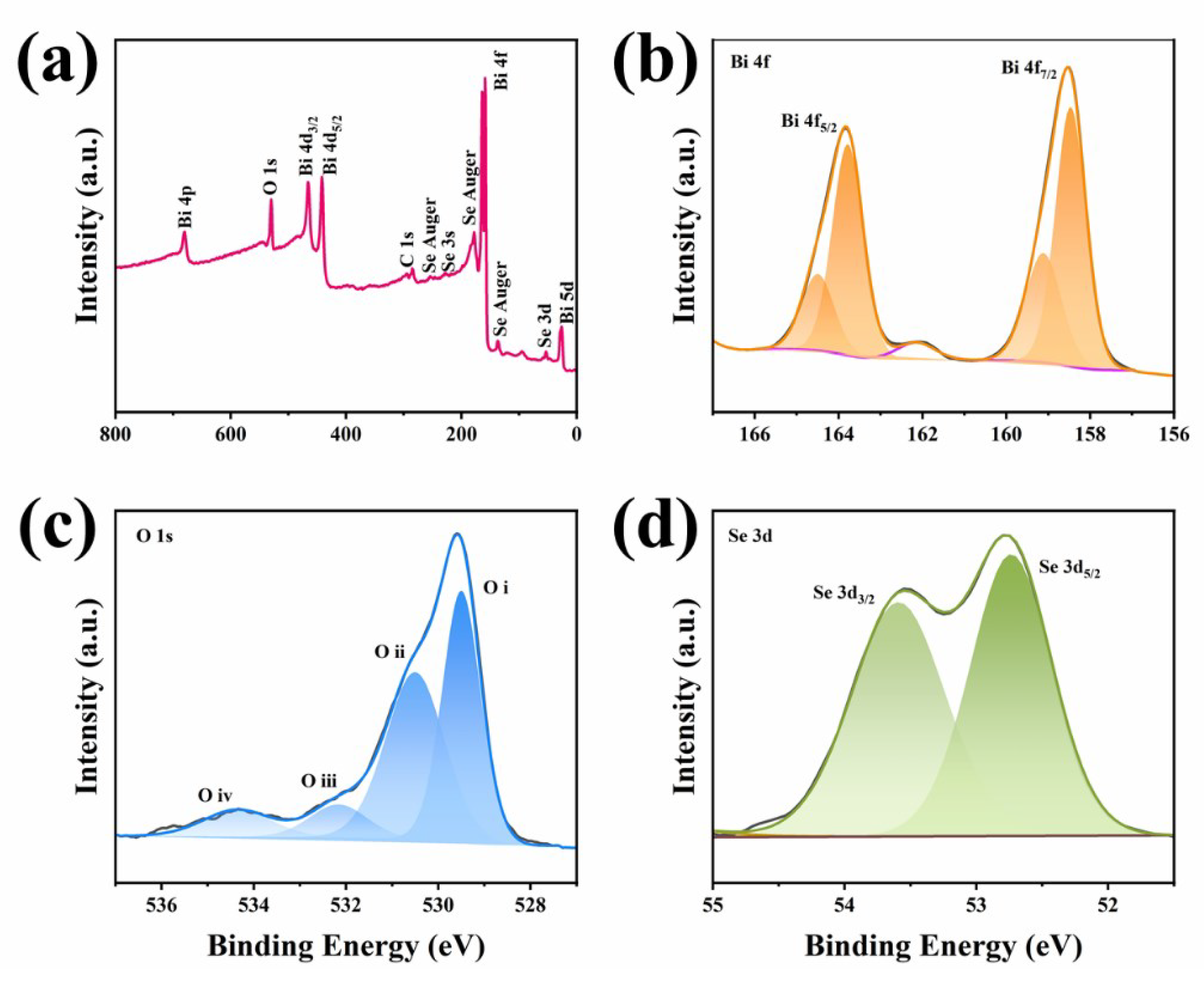
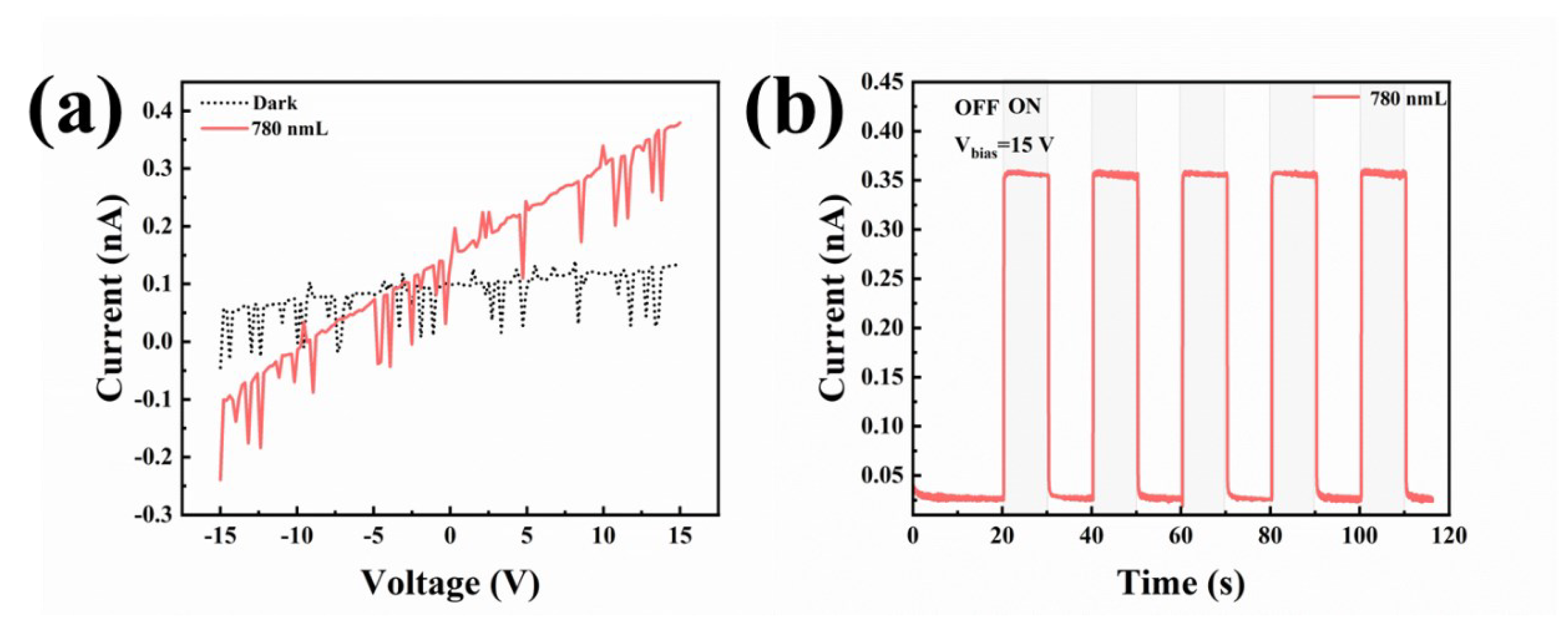

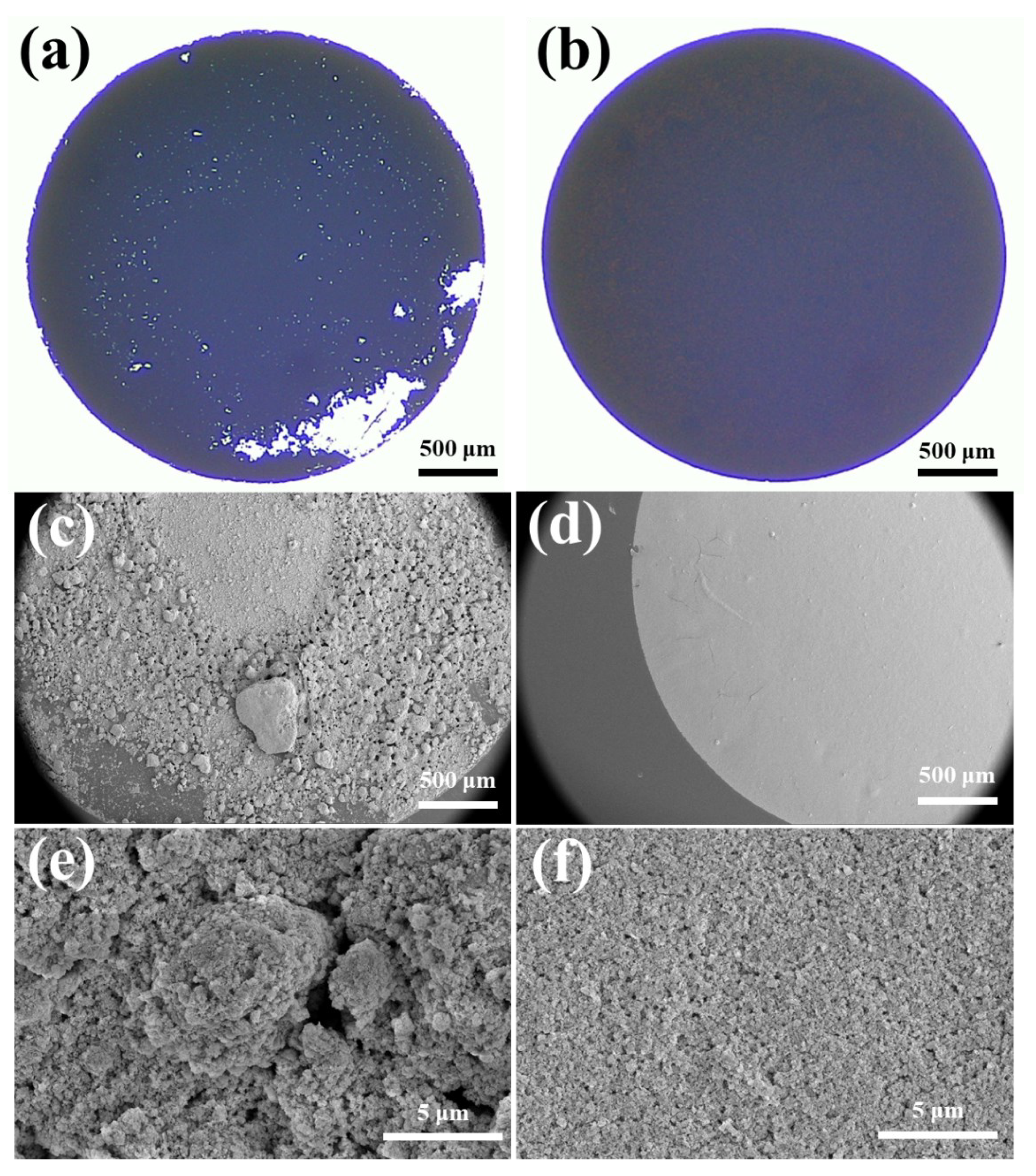
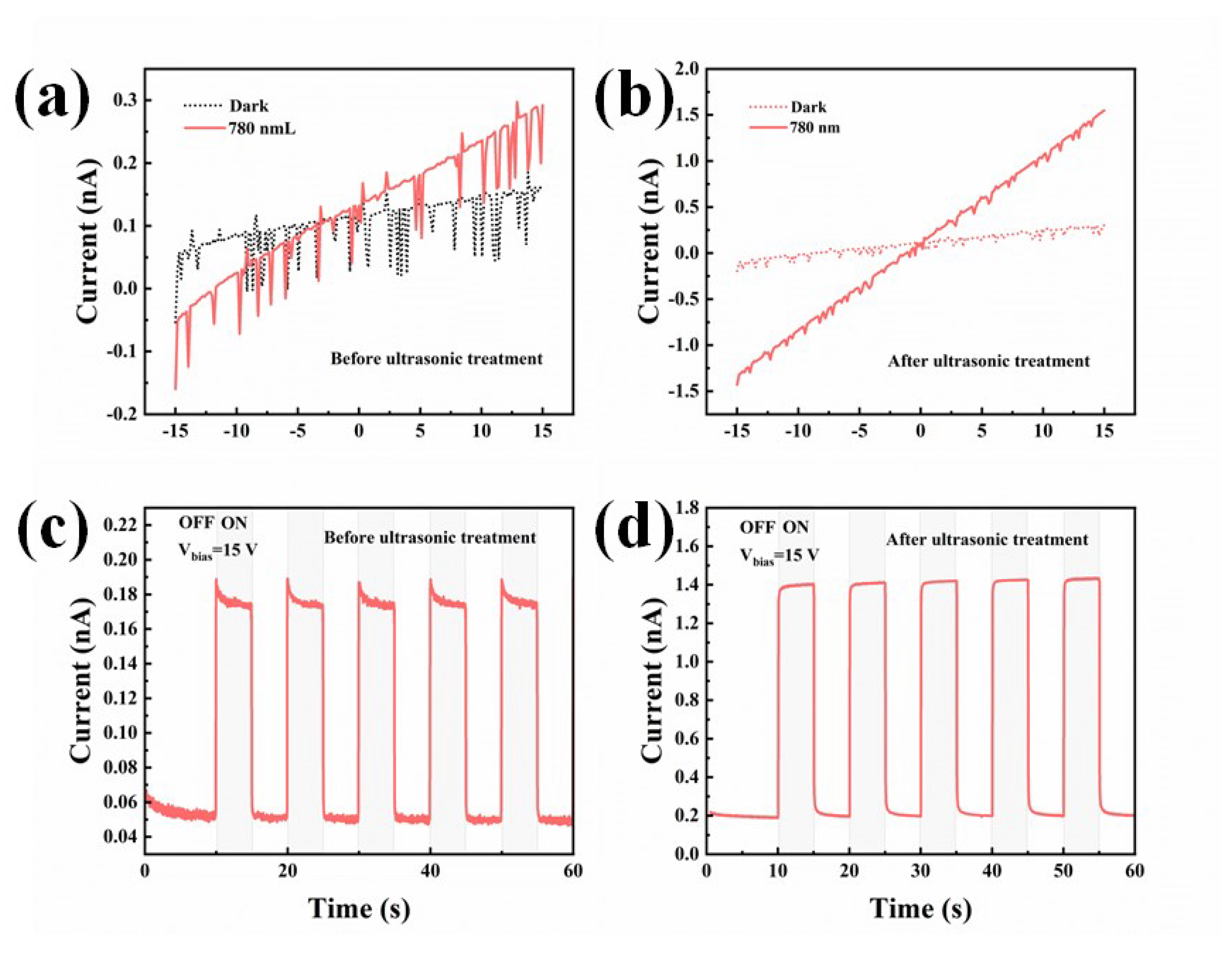
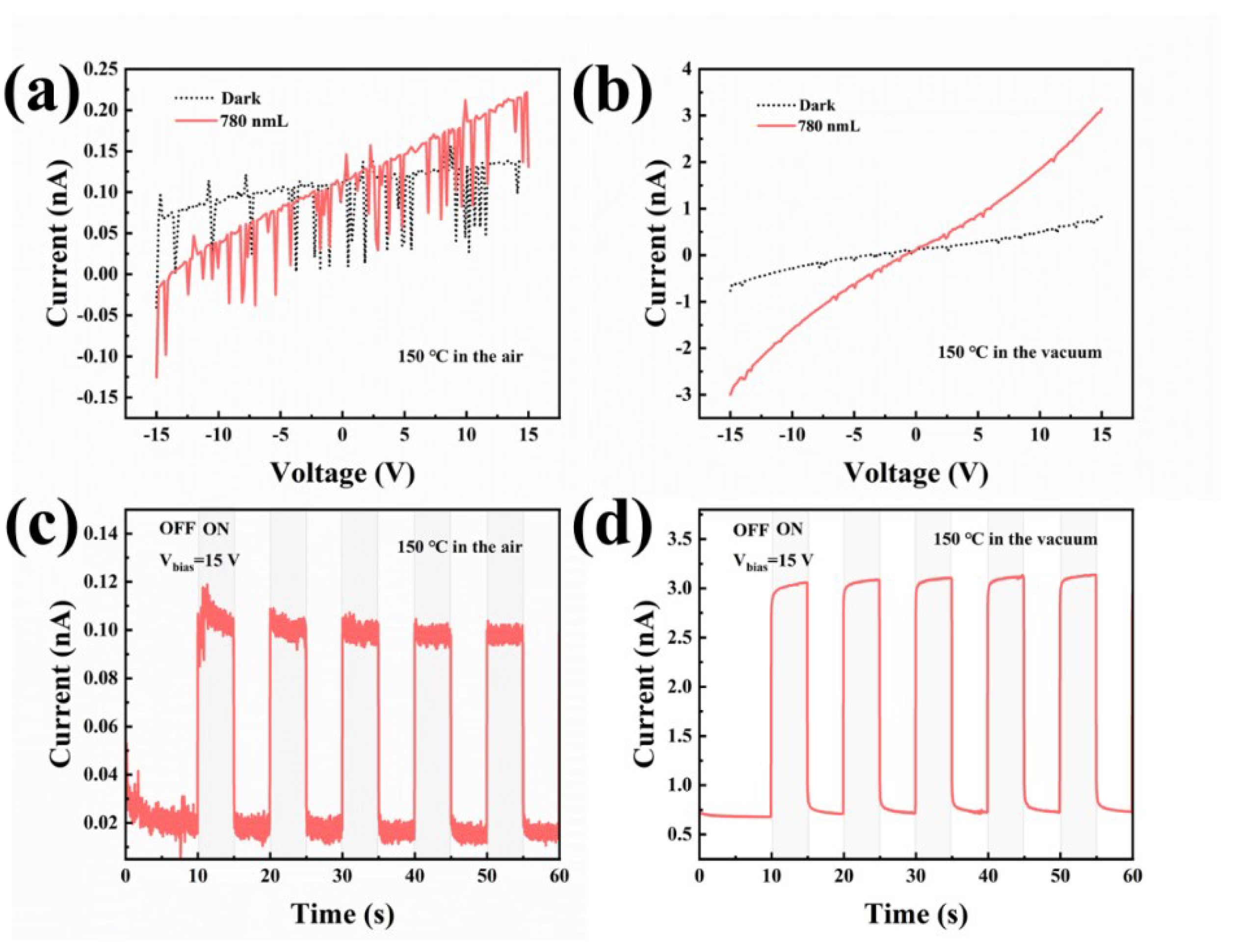
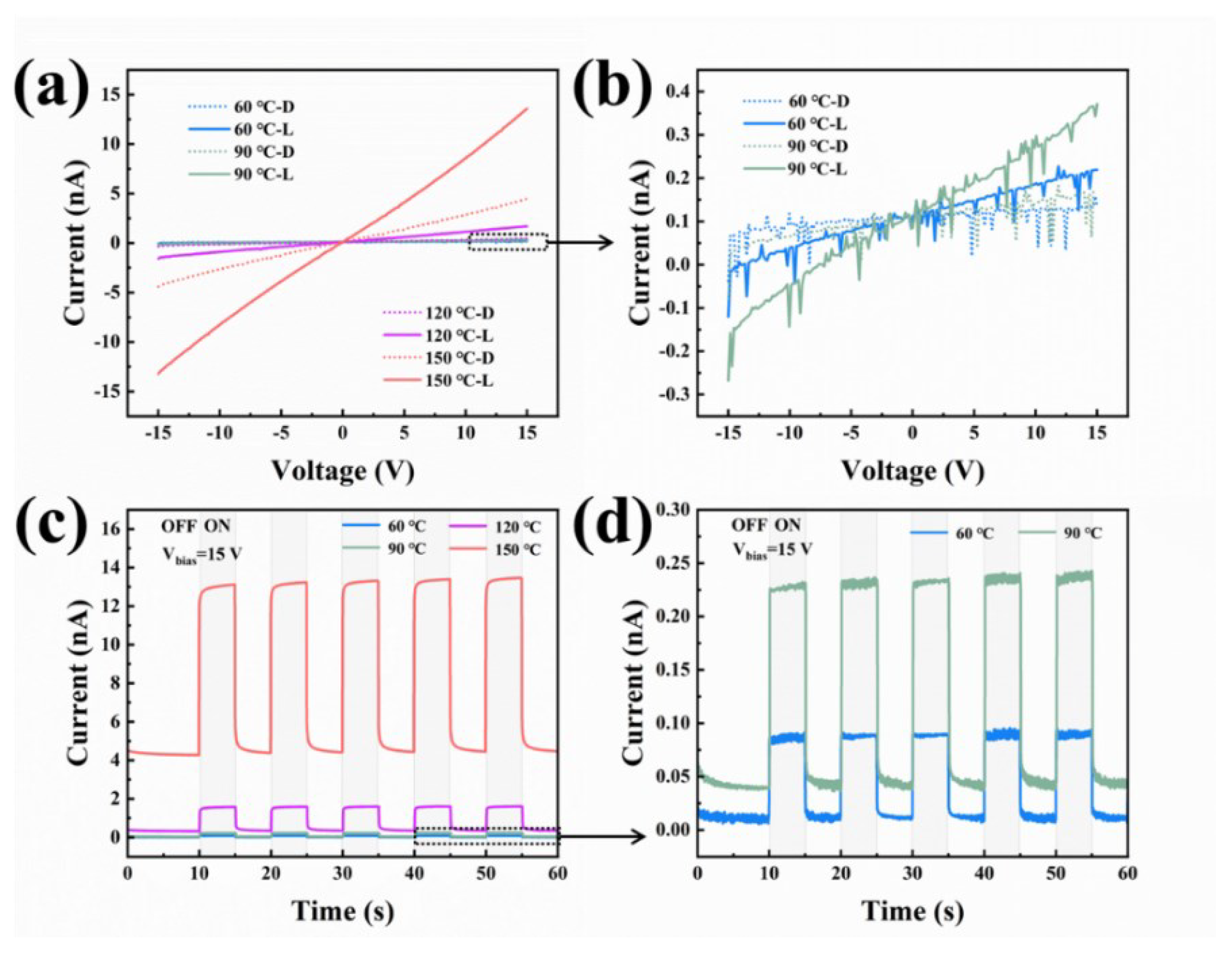
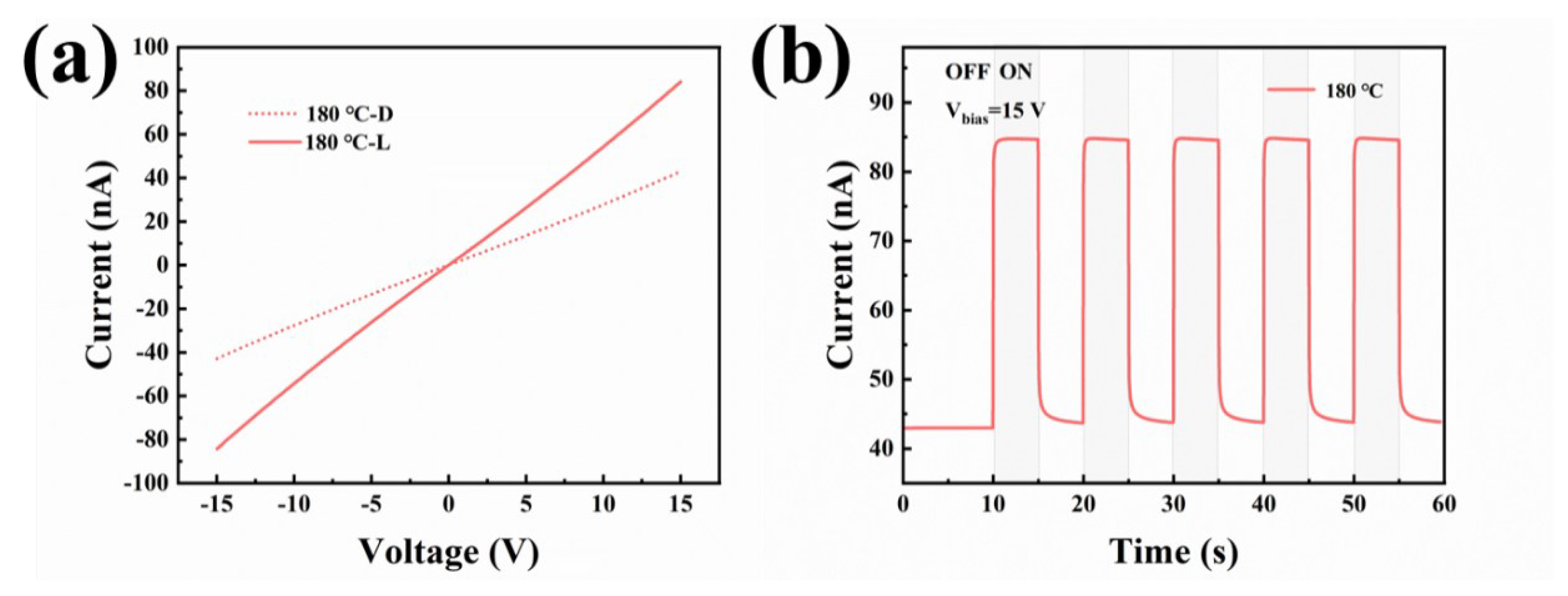
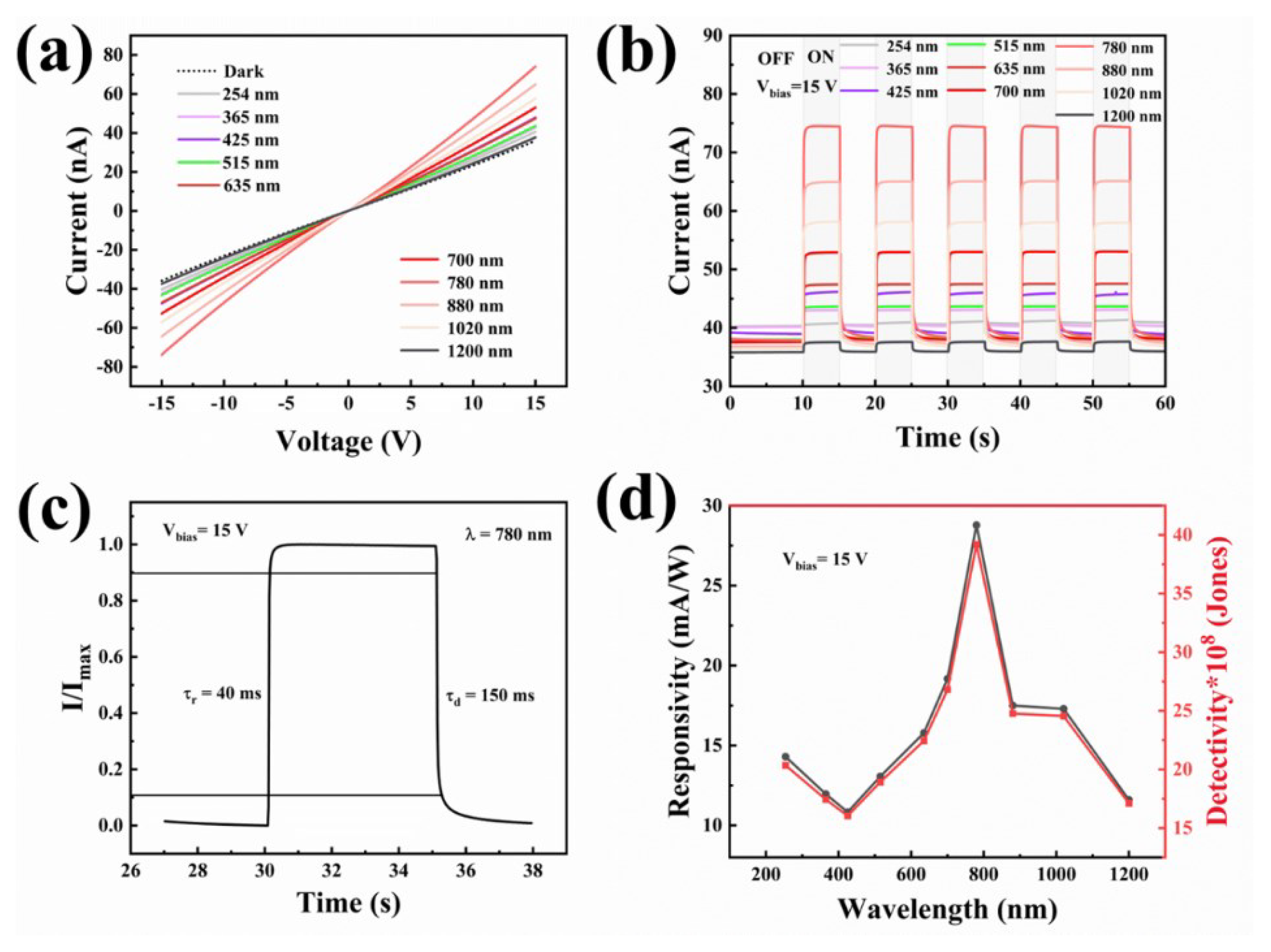
Disclaimer/Publisher’s Note: The statements, opinions and data contained in all publications are solely those of the individual author(s) and contributor(s) and not of MDPI and/or the editor(s). MDPI and/or the editor(s) disclaim responsibility for any injury to people or property resulting from any ideas, methods, instructions or products referred to in the content. |
© 2023 by the authors. Licensee MDPI, Basel, Switzerland. This article is an open access article distributed under the terms and conditions of the Creative Commons Attribution (CC BY) license (https://creativecommons.org/licenses/by/4.0/).
Share and Cite
Liu, J.; Han, Z.; Ding, J.; Guo, K.; Yang, X.; Hu, P.; Jiao, Y.; Teng, F. Preparation and Performance Study of Photoconductive Detector Based on Bi2O2Se Film. Photonics 2023, 10, 1187. https://doi.org/10.3390/photonics10111187
Liu J, Han Z, Ding J, Guo K, Yang X, Hu P, Jiao Y, Teng F. Preparation and Performance Study of Photoconductive Detector Based on Bi2O2Se Film. Photonics. 2023; 10(11):1187. https://doi.org/10.3390/photonics10111187
Chicago/Turabian StyleLiu, Jun, Zhonghui Han, Jianning Ding, Kang Guo, Xiaobin Yang, Peng Hu, Yang Jiao, and Feng Teng. 2023. "Preparation and Performance Study of Photoconductive Detector Based on Bi2O2Se Film" Photonics 10, no. 11: 1187. https://doi.org/10.3390/photonics10111187




